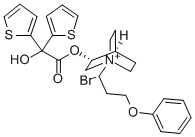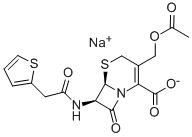AclidiniumBromide , 99% , 320345-99-1
CAS NO.:320345-99-1
Empirical Formula: C13H10BrN
Molecular Weight: 564.56
MDL number: MFCD22683690
EINECS: 825-171-6
| Pack Size | Price | Stock | Quantity |
| 10mg | RMB159.20 | In Stock |
|
| 25mg | RMB239.20 | In Stock |
|
| 100mg | RMB671.20 | In Stock |
|
| 500mg | RMB2079.20 | In Stock |
|
| others | Enquire |
PRODUCT Properties
| Melting point: | 230 °C(Solv: acetonitrile (75-05-8)) |
| storage temp. | under inert gas (nitrogen or Argon) at 2–8 °C |
| solubility | DMSO (Slightly, Heated), Methanol (Slightly) |
| form | Solid |
| color | White to Pale Orange |
Description and Uses
In July 2012, aclidinium bromide was approved in the US and the EU for long-term maintenance treatment of bronchospasm associated with chronic obstructive pulmonary disorder (COPD). Aclidinium bromide is in the latter category, acting as a selective antagonist for the muscarinic M3 receptor. M3 receptors are localized in airway smooth muscle, and are the primary subtype responsible for bronchial and tracheal smooth muscle contraction. Muscarinic antagonists are well-established bronchodilators that are effective for treating COPD, but these agents have unwanted side effects if systemically absorbed. Systemic exposure can be limited by inhaled administration, which is the route of delivery for aclidinium bromide. In addition, aclidinium bromide was designed to undergo rapid hydrolysis in human plasma, providing inactive acid and alcohol products, and reducing the potential for systemic side effects. Aclidinium bromide was identified amongst a series of quaternary ammonium (3R)-quinuclidinol esters as having the best combination of high potency (M3 Ki=0.14 nM), long duration of action (29 h for 50% reduction of therapeutic effect in a guinea pig bronchoconstriction model), low oral absorption, and rapid plasma degradation. The synthesis of aclidinium bromide was achieved by reaction of dimethyl oxalate with 2-thienylmagnesium bromide followed by treatment of the resulting methyl ester with (3R)-quinuclidinol in the presence of sodium hydride. Quaternization of the amine was achieved by treatment with 3-phenoxypropyl bromide to give aclidinium bromide.
Aclidinium Bromide inhibits human muscarinic AChR M1, M2, M3, M4 and M5 with Ki of 0.1 nM, 0.14 nM, 0.14 nM, 0.21 nM and 0.16 nM, respectively
Safety
| Symbol(GHS) |   GHS08,GHS06 |
| Signal word | Danger |
| Hazard statements | H361-H331 |
| Precautionary statements | P201-P202-P281-P308+P313-P405-P501-P261-P271-P304+P340-P311-P321-P403+P233-P405-P501 |



